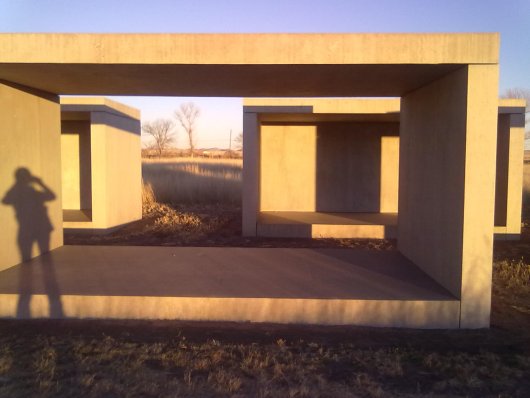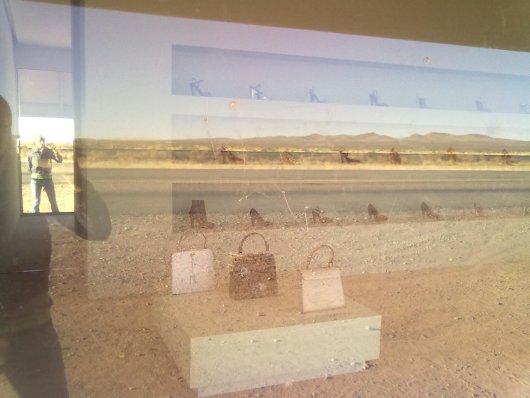 THE WORLD
THE WORLD « In Which Nothing Protects Us From Moving On »
 Tuesday, May 22, 2012 at 11:12AM
Tuesday, May 22, 2012 at 11:12AM 
This Is
by SARAH WAMBOLD
I asked three different friends to join me on a trip to Marfa, TX and none of them found the matter as urgent as I did. They said they would look into it but then decided to wait until something was going on out there. I could see that they would go to Marfa only when nothing was keeping them from it. I wrote about my first experience in Marfa in a hurry. I was full of ideas the moment I got there. Later on, I heard those same ideas come out of the mouths of my friends who eventually did go to Marfa. The words had disappeared from where I originally wrote them, but left a space for me to return. I went to Marfa alone for nothing.
I drove to Marfa in seven hours, going 85 the whole way. I felt rushed by the empty road, surprised by how quickly I could become a cliché. It is true that thousands of tourists have traveled the same route I took, but they had all disappeared before I got there. Eventually, we would come upon each other, staring into the distance beyond us rather than make eye contact. Out there, we could pretend we were following our own lead.
 photo by the author
photo by the author
I want to crawl inside Paul Valery’s quote, “God made everything out of nothing, but the nothingness shows through,” and see if I can still write about it. He wrote that line a quarter of a century after he spent twenty years learning how to write invisibly. Periods of silence and space are associated with crisis but sometimes language has simply taken another form.
I arrived in Marfa presciently inspired; it’s a town with an aura only seen by cattle ranchers and artists. It has the same provincial train tracks, sunlight and rusted gates that hold back the West Texas desert as any town in its vicinity, but Marfa is tastefully flaking away. Rust has become the design element for the hotels and gallery owners who have set up there since the town became a destination in the 1970s. A quick look around is like a close reading of hipster ipsum:
Farm-to-table leggings, fanny pack mustache
Tattooed dreamcatcher readymade gluten-
free skateboard art party Austin jean shorts
keytarscenester, bicycle rights vegan.
I take a drive west out of Marfa and see a sign that warns of no services for the next 74 miles. It recalls where I grew up; in the Midwest surrounded by inescapable farmland framed by signage with the same dismal promise of the future. Without those words, I would not have known how to get outside of them. As I drive, Prada Marfa appears like a shapely leg poised on the side of Highway 90, one that reveals itself to be just a prosthetic.
 photo by the author
photo by the author
Outside that installation, I take a picture of my reflection on the glass window with my phone. It feels like I am helping in the destruction of the piece, contributing to its purpose of weathering into the desert with pastiche. Marfa is home to some of the most inspired Minimalist art and seduces tourists into becoming artists in its space. The results are like images from a flipbook, all part of the same story where the slightest shift in perspective keeps it moving towards the end.
 photo by Elaine Litzau
photo by Elaine Litzau
On my final night alone in Marfa, I went to the Chinati Foundation at sunset. Open that evening was Donald Judd’s works in concrete and mill steel. The air was brisk as we waited by another rusted gate to be let into the area which had been a military compound used through World War II. In the distance, what looked like a construction site in flux awaited our arrival. The fifteen concrete block installations that make up Judd’s outdoor piece appeared as burial vaults. The same concrete structures which could hold our precious remains were now uprooted and tipped over, empty of the sludge that will become of us.
As I walked past, the desert sunset cast my shadows through them. I thought about my grandfather’s vault, emblazoned with his military symbol from the war. I thought about his body, fast disappearing inside that box.
 photo by the author
photo by the author
Many of Judd’s structures have only one end open, forcing you to focus on their corners and shadows. If you turn halfway around, you are met with open space. After a full revolution, the box is open and empty and space. In Marfa, Judd can say “The public has no idea of art other than something portable that can be bought.” Outside it, burial vaults are sold as protection from the elements, eventually becoming all that is left of the person it once held. In Marfa, there is no funeral home. The desert town’s residents are close to their deterioration. Nothing is protecting them from time moving on.
The day I left Marfa, I got up before sunrise to look for the Marfa Lights. I sat alone on the viewing platform and watched three glowing orbs float above the horizon. They moved across the desert toward me and I could see how people viewed them as only the headlights of cars passing along some distant road. Beyond that, I couldn’t see anything at all.
Sarah Wambold is the senior contributor to This Recording. She is a writer living in Austin. You can find her twitter here. She last wrote in these pages about synchronized swimming.

"Ocean Eyes" - The Medics (mp3)
"Griffin" - The Medics (mp3)
The new album from The Medics is called Foundations, and it was released on May 18th.

 donald judd,
donald judd,  marfa,
marfa,  paul valery,
paul valery,  sarah wambold,
sarah wambold,  texas
texas 





























Reader Comments (2)
Funny story...they were filming "There will be blood" while we were there. Since there's only one fancy restaurant in town, Maiya's, Daniel Day Lewis ended up in all our wedding reception photos. Mustache and all.